Is less more? I associate the familiar phrase with Ludwig Mies van der Rohe, one of the founders of modern architecture and a proponent of simplicity of style. But when I went to confirm this, I found to my surprise that the phrase was first used in print in Andrea del Sarto, a poem by Robert Browning.
Who strive – you don’t know how the others strive
To paint a little thing like that you smeared
Carelessly passing with your robes afloat,-
Yet do much less, so much less, Someone says,
(I know his name, no matter) – so much less!
Well, less is more, Lucrezia.
Regardless of its origin, the phrase is well worth remembering — and well worth applying in the garden. Pruning, dividing, getting rid of whatever is too much — doing this can improve a garden enormously.
So we’ve been working to make less of the garden at Glen Villa these last few months. Not by shrinking the size but by removing the excess. A section along a path through the woods, for instance, has gone from this…
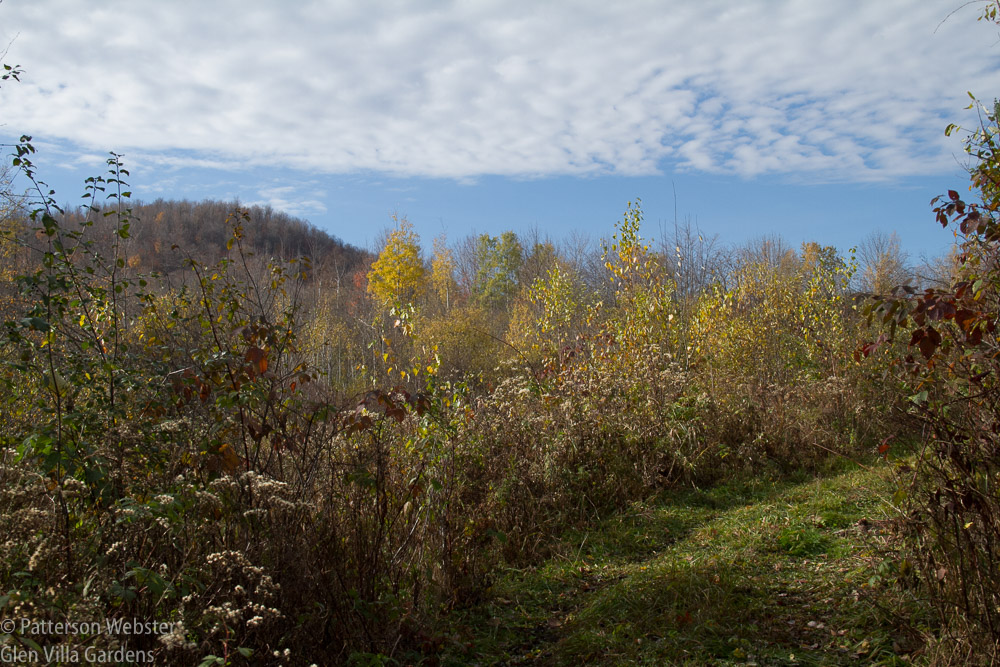
We cleaned up this section in the woods for the first time about ten years ago. I’m amazed at how quickly things grew back.
to this.
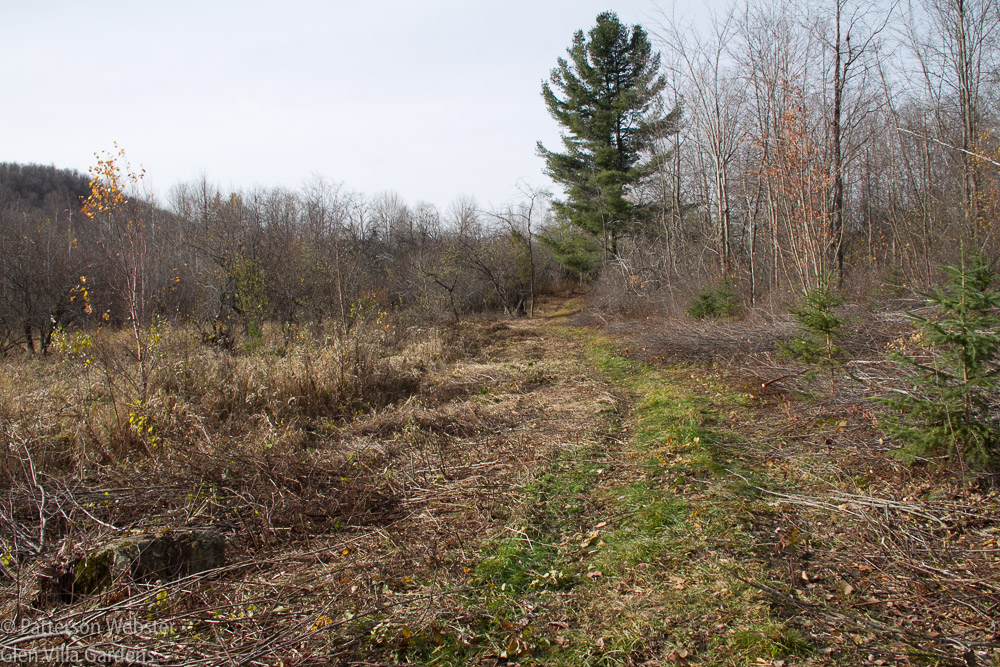
Amazing what you can see when you clear out the brush.
The view on a grey day is not as appealing, perhaps, as a picture from earlier in the season, but the site will be better nonetheless for the severe hair-cut we’ve given it. Why? Because the growth that originally protected the seedling evergreens we planted was threatening to overwhelm them.
Over several days last month, the area was trimmed down and the brush chipped up, exposing those rapidly growing trees to full view.
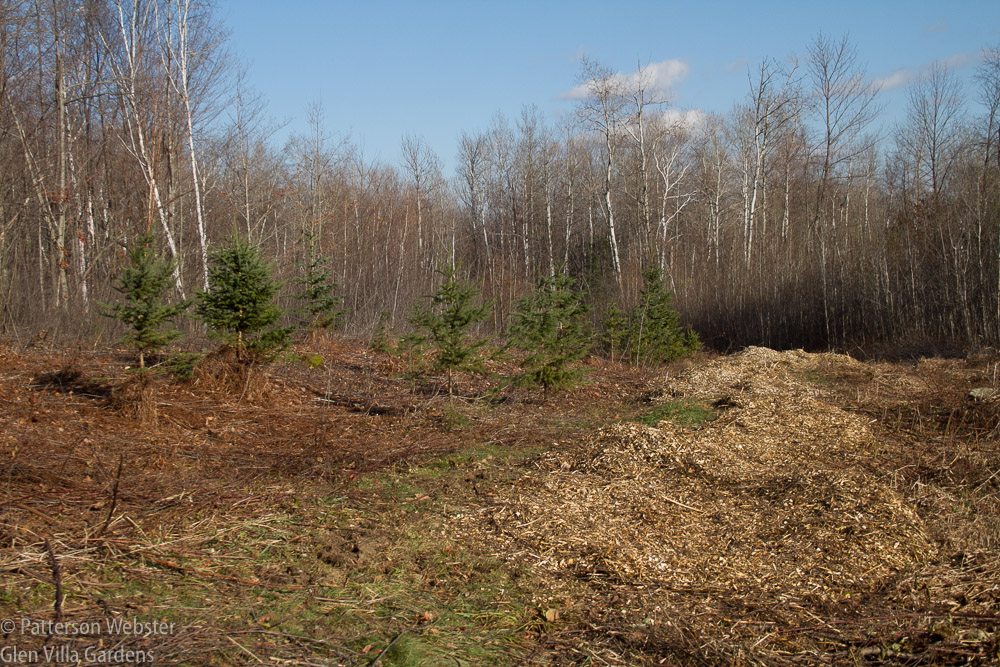
This view looks in the opposite direction from the two photos above. The piles of chips are now spread on the path, leaving room for the trees to grow.
Next year we will do the fine-tuning to make this area more attractive, but in the meantime, we left that area to do a quicker clean-up closer to home.
This particular clean-up shows how easy it is to become accustomed to things as they are. A friend walking around the garden in late October suggested that the view of the waterfall could easily be improved by removing a single tree.
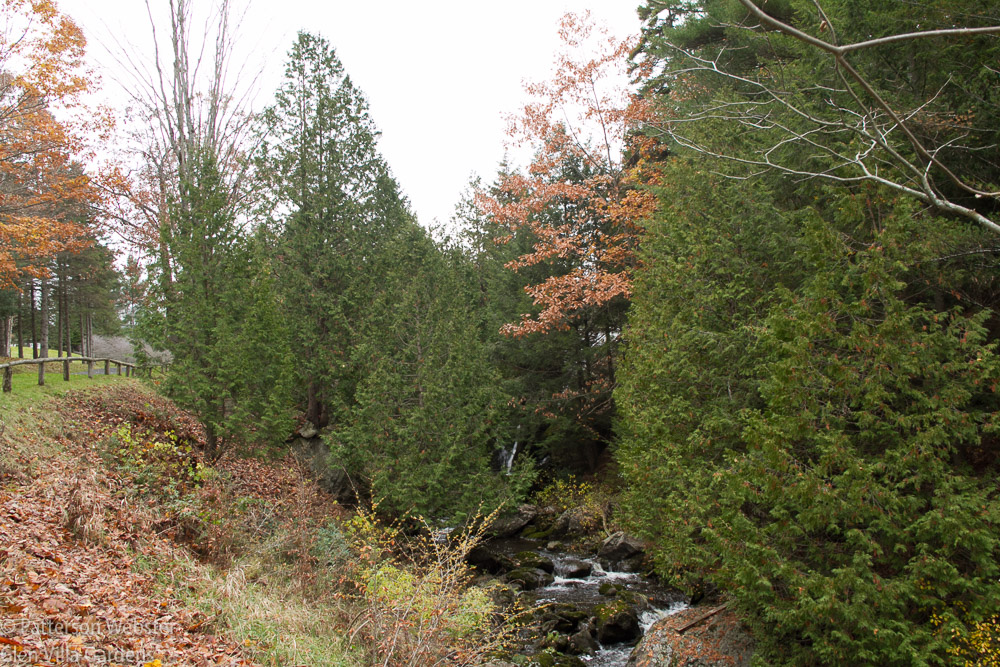
Our visitor pointed out, quite rightly, that trees were blocking what should be a view of the waterfall.
Taking down one tree improved the situation but still left the waterfall hidden.

Notice the rock at the foot of the cedars on the left side of the photo. Taking down the first tree exposed it to view. Removing dead branches on the other side of the stream opened the view even more.
Taking down two more trees completed the job. The enormous boulder that gives the waterfall so much of its character is now clearly visible. (So thank you for the suggestion, Jordan!)
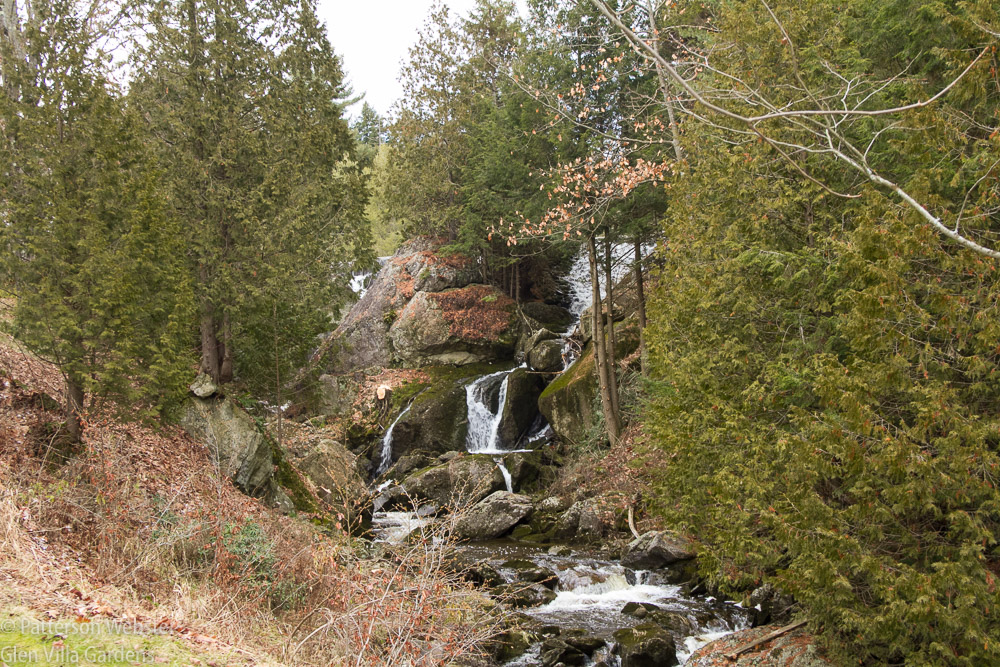
The improvement is striking — particularly now that the waterfall is operating again as it should.
Our final clean-up job is almost complete, and what a difference it has made! Some 15 years ago, we planted a group of hawthorn trees by the entry to Glen Villa. Over time, their canopy had become thicker and thicker. And anyone who is familiar with hawthorns knows how daunting their thorns can be. So while pruning was clearly necessary, we always put off doing the work.
In 2011, the trees looked like this.

I took this photo to remind myself that the trees needed to be pruned. And that was five years ago.
The trees in full leaf looked as bad as the leafless ones, possibly worse. Their canopies were so crowded that the shape of the tree was totally hidden.
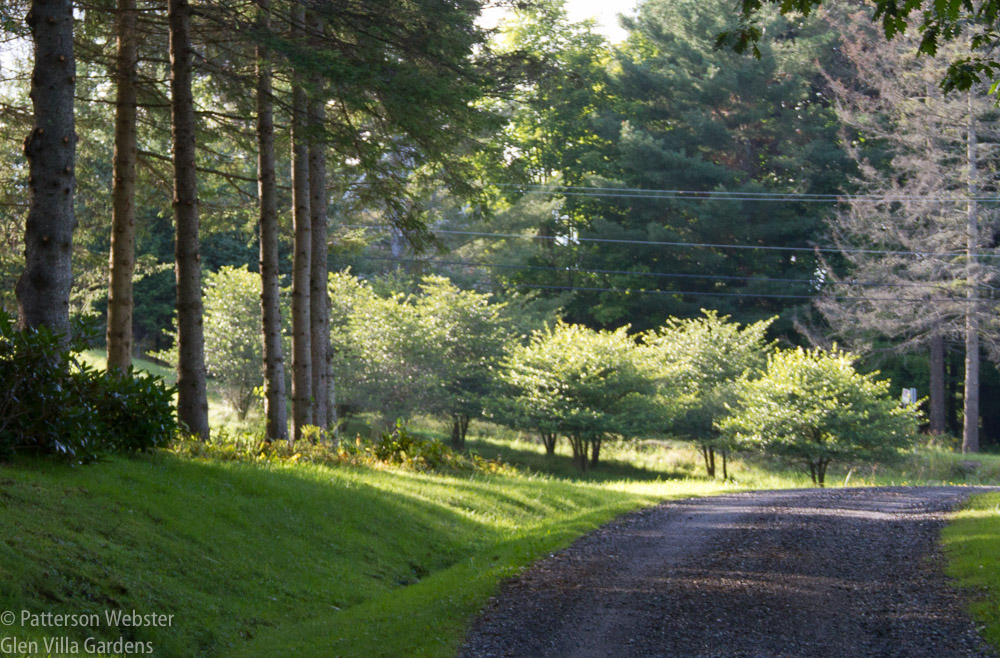
This is the best photo I could find of the trees in leaf, and it is a cropped version of a photo I took to show the cleaned-up area under the spruce trees on the left. Obviously I didn’t want to photograph something I found unappealing.
Now the hawthorns look thinner.
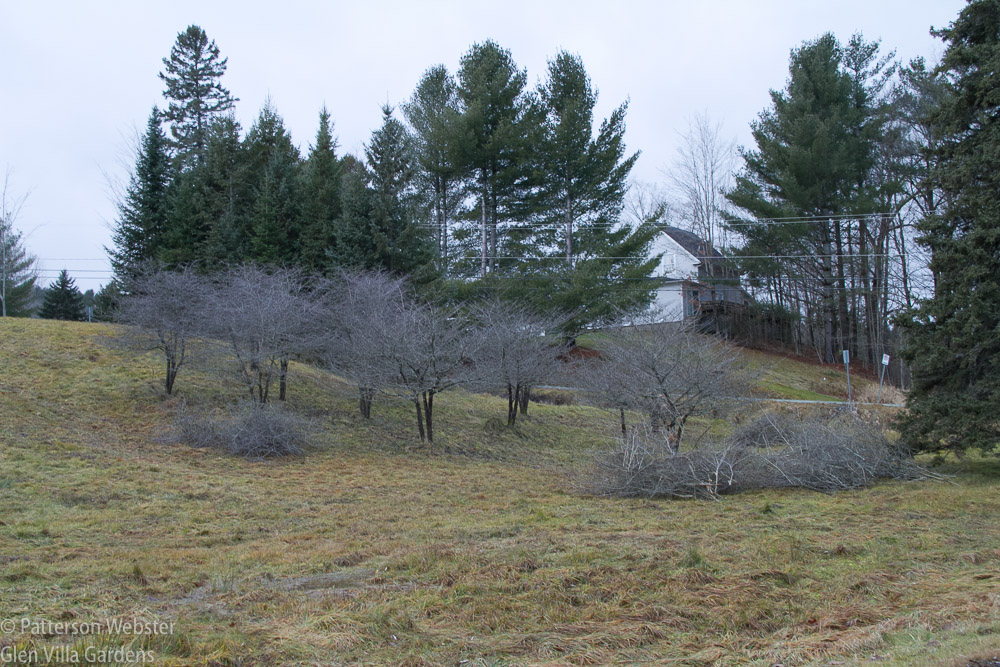
A grey day can make the spirits droop and make me wonder if pruning these trees now was the right thing to do. But if not now, when? On a sunnier day, or in a different season, the job would be put off again. Or so I suspect.
One tree remains to be pruned, and that will take place this week, all going well.
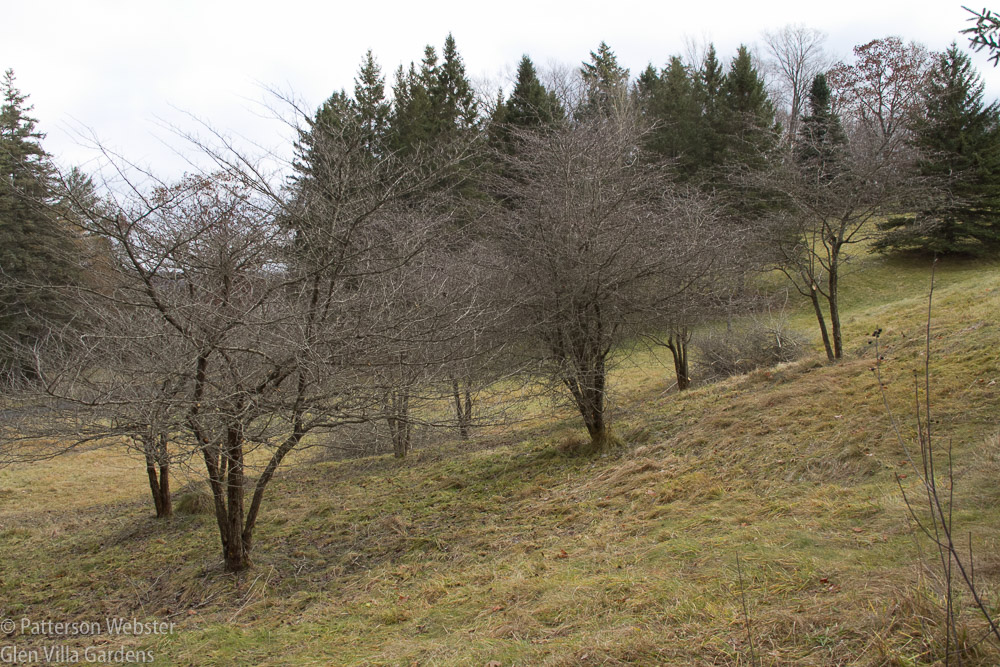
I think it is easy to tell which tree still needs to be pruned. Do you agree?
Have we taken out enough? too much? Next year will tell the tale. But the size of the piles says that we need to prune these trees more often.
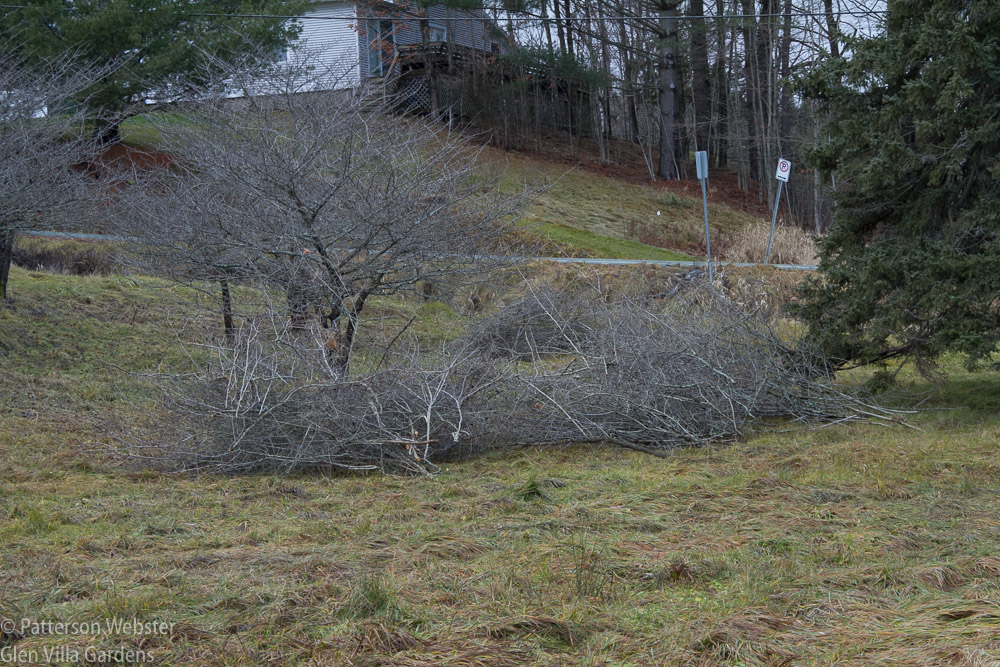
This is only one of four piles of brush.
The shape of the tree that is revealed once the pruning is done makes the job worthwhile.
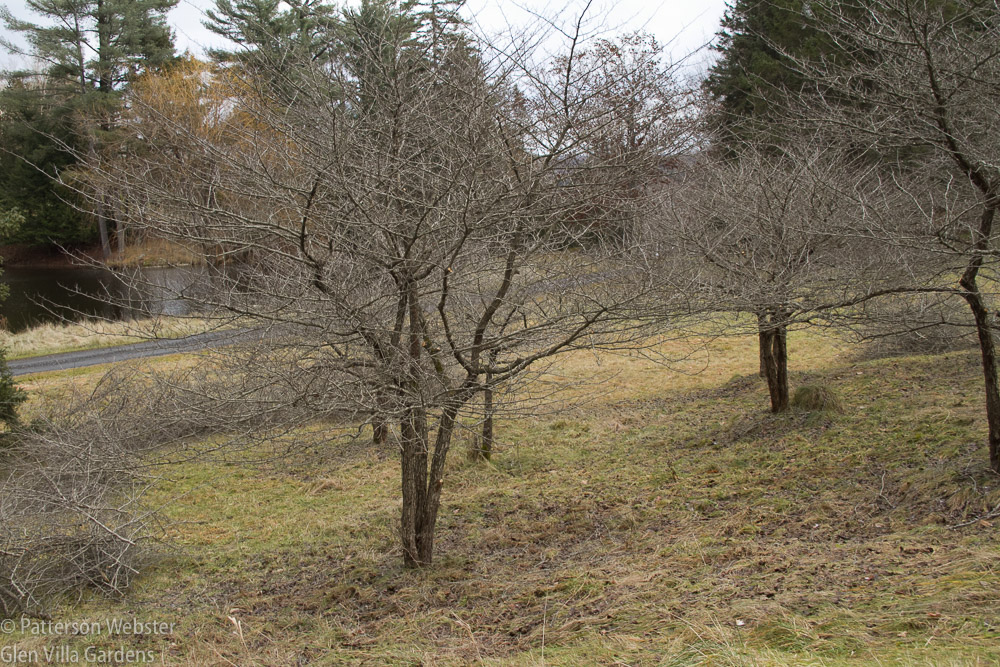
I think a more shapely tree looks better. I also think we may need to prune almost as much again next year. I hope I’m wrong.
If cleaning up cupboards and drawers gives a certain satisfaction, then cleaning up trees and woods gives even more. The trick is knowing when to stop. Because once you start looking, areas just waiting to be thinned out appear as if by magic. My friend John Hay spotted this one last weekend, and cleaning up here is the next job on the list.

Clearing the undergrowth and selectively removing scrubby trees should reveal a stunning rock formation. Thank you, John!
As satisfying as a good clean-up can be, though, less is not always more. Sometimes it is simply less.
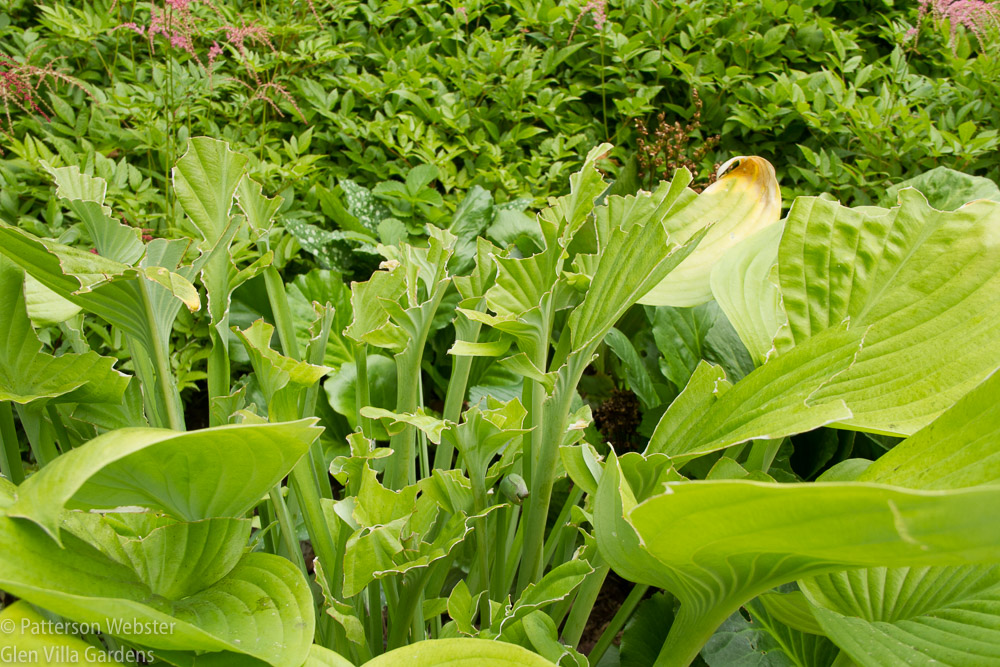
No prizes for guessing who pruned this hosta.
Are you in the midst of a clean-up, indoors or out?







Not got time to study your changes in detail, but very grateful for the origin of the quote (great poet, that one..) and the theme. You have very good friends, pointing out what you were missing. So easily missed, changes just come while we fail to notice (it’s called confluence!) and we need something/someone to help us see freshly.
And, of course, people do stuff too much into their gardens (and our homes). It’s a good exercise when visiting a garden or wandering your own to decide what would benefit from a vanishing trick. Well reminded. XXxxx
Browning is one of those poets who gets better with age, I think. I remember disliking him when I was in my 20s. No longer.
And yes, trying to decide what to remove from a garden is a great mental exercise. Hard, though, since most of us prefer to keep stuffing things in. (Was that what motivated Ian H-F?)
Ian H-F did far too much stuffing. When Charles was photographing he had a major problem only getting one thing in a shot…. Clutter, I call it!
As we speak, we are having some huge sycamores down! Light! Air! View of the forest beyond! Hurray for removal! (and lots of logs for the fire…) XXXXX
I can’t decide about too much or too little at Little Sparta because I think it varies from one part of the garden to another. In that dark mossy area near the pond, there is far too much for my liking. In the English parkland, he comes close to the line, as he does in the section you enter through the gate from the road. In the moorland section above the pond I think he found a good balance. The three lines of stone walls, the single shadow post, the big chunks of engraved stones — each has its place and works well in the setting.
As for logs for the fire, there can never be too many.
You’re right about logs! And maybe about Little Sparta – it’s too many years since our visit for me to be clear about the detail. I love someone being detailed though, love it. Xxxx
One acre at a time is just fine!
Slow progress but sound advice.
I find pruning very satisfying. But it’s true there is no end of it, especially in a year with plenty of rain and no freezes, like Austin experienced over the past year. The plants have simply exploded in growth after years of drought. I have major pruning plans this winter as well. I think I would be daunted with a property of your size though. How in the world do you manage?
By the way, your waterfall is stunning. Nice job on revealing it, and the (now) shapely hawthorns again too. Pam/Digging: penick.net
I LOVE to prune — a good way to impose my own views on a tree or shrub, or (more charitably) to let the tree or shrub reveal its true beauty. I find it soothing to the spirits as well. How do I manage? Not as well as I’d like, particularly the older I get. I keep waiting for the patience that age is meant to bring, haven’t encountered it yet.
The waterfall is truly magnificent now that water is pouring over the dam as it should. Still waiting for the permits to dredge the pond, though… maybe next summer.
I am in the ‘commission by ommision’ guilty camp when it comes to maintaining views. Laziness? Budget priorities? Overweaning desire for privacy? Not sure, but this is an oft-overlooked part of designing a garden, or even maintaining desirable vistas in a naturalistic space. Well done.
The danger with pruning is going too far. Trees and shrubs can recover but a less-than-skillful pruning can harm the shape beyond belief. Sometimes I stand and look for far too long, deciding what to remove. So I understand your ‘commission by omission’ stance. And sympathize with it.
Currently I’m trying to “prune” the piles on my desk. I tend to save outdoor pruning for the tail end of winter, when I’m itching to get out of the house anyway. Last mud season, I bravely pruned the Japanese maple outside the front door. Then we had that wicked cold snap that severely damaged the much more cold tolerant yews, and the Japanese maple languished all summer, and I fear will be no more next spring. I always wonder if I had waited a little longer into spring to prune it, would it have survived the cold snap better?
I’m desk-pruning too, Kathy, and going through old files. It’s amazing what doesn’t need to be saved. And I can easily (too easily) fill the empty space with new junk!
Amazing! I would not have believed the difference pruning would make until I saw your beautiful photos! The waterfalls looks stunning as do the rocks . Bravo !
Marni B
Thanks, Marni. I was equally surprised at the difference.
I drove by your pond yesterday and was happy to see it has returned to its former lovely self!
We may have to drain it in January to do some repairs — but like you, I’m happiest when the pond is at full strength.
Editing is such a big part of gardening. First we stuff it all in. Then we tear half of it out. But the plants, quite literally, have more room to shine when given their own space. Too much is just too much.
Editing takes courage, I find. But I love to prune. And to remove dead wood, whether the ‘wood’ is actually wood or just a plant that isn’t doing well. Now, about my filing drawers…
Wonderful work! The waterfall is quite stunning. Pruning the yews is great : trees have such beautiful shapes, but just like us, they need a bit of trimming sometime. The evergreens must be happy to breathe again. Ever seen the documentary about what would happen if mankind disappeared on earth? Nature really takes over, big time! About the hosta? Shhhhhhhh…
I once saw a video about nature taking over, shown in time gaps of 10, 50, 100, 200 years or some such. It was memorable, and rather frightening. But will the deer always be with us?
In most cases in the garden I am in favor of more. There are exceptions, however, and you illustrate them well. Early this past summer I helped a friend prune a couple of lilacs that had been neglected for decades. A huge job, but well worth it.
Lilacs and forsythia are two of the shrubs I most like to prune. Very satisfying!
I admire your being willing and able to do it. I think the prize goes to the waterfall.
I agree, James. The improvement was much more than I’d anticipated. Happy New Year to you!